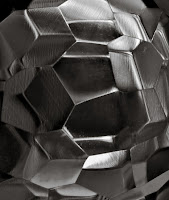"If metaphor is a verbal
strategy to evoke images,
then as a photographer
I’m interested in
combining images
to alter associations by
extending the image itself
...
It is this act
of transformation,
interactivity between images,
that I find the most challenging."
-
Nathan Lyons (1930 - 2016)
Postscript / Slightly-convoluted aside on the creative process. I'm still experimenting with what to do with a storehouse of marble abstracts (from c.2011) that I recently "re-discovered" on an old hard-drive during my almost year-long COVID-19-induced "creative convalescence." While the photographs work by themselves - just as straight images - I've started playing with other ways of displaying them. What got me started was the fact that the best abstracts consist of (or possess) multiple overlapping regions that are just as strong if displayed separately. This aesthetic dilemma is both trivial and deep. It is trivial, because it is really no different from the most basic aesthetic judgement that all exposures depend on; i.e., framing. But it is also deeper, because - tautologically - a completed image can only reveal what the intentional framing allows it to reveal. Ironically, the deepest aesthetic value of an image (whether it is intended by the artist or not) may lie hidden, in latent form, discoverable only by discerning the full inherent richness and complexity of the Gestalt of (the myriad entwined parts of) an image.
What do I mean by this, on a more practical level? I first toyed with deliberately breaking up a selection of my marble abstracts into triptychs, literally breaking the images up into equal thirds. I did this not because I thought the images "looked better" when dissected in this way, but because - for the cases I selected - each individual panel proved to be as strong an image - by itself - as the abstract as a whole. But the whole images proved too intrusive - they made it hard to "see the trees for the forest." I next played with making
random triptychs, assembling them from a pool of individual 1/3-sized panels (i.e., a candidate triptych consists of a random panel from a random image X, a random panel from a random image Y, and a random panel from a random image Z, keeping only the ones I "liked”). That exercise proved mostly fruitless. While I found a few stray triptychs mildly interesting, most were - sadly but obviously - "less than the sum of their parts." Then I tinkered with constructing triptychs-of-triptychs, but that soon got unmanageable, and the results (except for a few notable
exceptions) were less than stellar. (I also experimented with randomly assembling 3-by-3 blocks of parts of images, but the less said about
that effort the better.)
And so, we get to the image you see posted on top, which is but one of a fairly large portfolio I've convinced myself I really like; but which also took me a while to understand
why (of course, your taste may differ). First, in the context of the labyrinthine "creative process" I just described, the image represents a rather "simple" excursion from just displaying the
whole image. Indeed, the "algorithm" (if that is what I dare call it) is to split an image into three parts as before, and choose the "best" (most pleasing?... most interesting?... in practice, whichever one "holds my gaze longest") among the three possible juxtapositions (i.e., 1st and 2nd panel interchanged, 3rd panel fixed; 1st and 3rd panel interchanged, 2nd one fixed; or 2nd and 3rd panel interchanged, and 1st panel fixed);
that's it! What makes it work is that - unlike an image that is just broken up into thirds (wherein you "see" the whole even if any of the individual panels strikes an interest on their own) - the whole in this case is objectively
invisible (or visible, but only in latent form) - but is nonetheless
implicitly still within sight, "just barely out of reach." The viewer is thus afforded a meditative space in which to quietly view and absorb the individual panels, all the while being gently reminded that none of them is the complete story. Indeed, it comes tantalizingly close to letting one to see - in true
Goethian fashion -
both the whole and its parts simultaneously. Some of the better examples of this (such as the one at the top of this post) induce a dynamic unresolved tension (in me, at least) between seeing the "whole" and "seeing the parts" (along lines of the infamous
Necker cube or Wittgenstein's
Duck-Rabbit); and take a step toward enticing the viewer to appreciate an image as "more than the sum of its parts."
"Abstract formal elements are
put together like numbers and
letters to make concrete beings
or abstract things;
in the end a formal cosmos
is achieved so much like
the creation that a mere breath
suffices to transform
religion into art."













